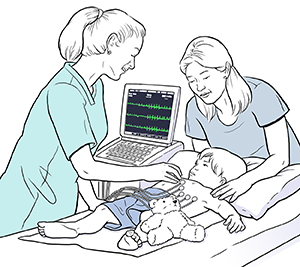Your Child's Heart Rhythm Monitoring
The heartbeat is the strong, rhythmic pattern of heart muscle squeezing to pump blood to the body and lungs. It’s controlled by electrical tissue in the heart, called the conduction system. The rate or pattern of the heartbeat is known as the heart rhythm. Abnormal heart rhythms are called arrhythmias. These can cause your child to have symptoms such as lightheadedness, dizziness, low blood pressure, fainting, or fatigue. In rare cases, arrhythmias can cause more serious problems. To help the healthcare provider learn more about your child’s heart rhythm, tests can be done. These include:
 |
| During an ECG, leads are placed on the chest, arms, and legs to check for problems with your child’s heart rhythm. |
-
Electrocardiography (ECG). This test records electrical signals from your child’s heart onto a paper strip. The pattern of these signals can help your child's healthcare provider tell whether your child’s heart is normal, under stress, or having electrical or rhythm problems. This test can also show problems with the pumping mechanism of the heart. It lasts less than a minute.
-
Holter monitoring. A Holter monitor is a portable device that your child wears as they go about their day. It records your child’s heart rhythm nonstop for 24 to 48 hours. It helps your child's healthcare provider check for arrhythmias that occur often but randomly.
-
Event monitoring. An event monitor is a portable device that your child wears for up to a month. It records your child’s heart rhythm when symptoms occur. It helps your child's healthcare provider check for arrhythmias that occur randomly and infrequently. When symptoms occur, you or your child can press the button to record the heart rhythm at that moment.
Your child’s experience: Electrocardiography (ECG)
-
Before the test. Your child should wear loose, comfortable clothing for easy access to the chest.
-
During the test. Your child lies still on an exam table. Electrodes (small sticky pads) are placed on your child’s chest, arms, and legs. The electrodes record your child’s heart rhythm and any changes in the heart signals that occur during the test. After a few minutes of recording, the technologist takes off the electrodes.
-
After the test. Unless told not to, your child can go back to their normal routine. Your child's healthcare provider may give you early results after the test. You’ll get complete results when the ECG has been fully reviewed.
Your child’s experience: Holter monitoring or event monitoring
-
Before the test. You may need to take your child to the hospital to get the Holter or event monitor. Arrangements may also be made with an outside company to have someone deliver the monitor to your home and show you how to use it. With a Holter monitor, the electrodes are connected from the monitor to your child’s chest. The monitor is normally worn around the waist on a belt or over the shoulder in a bag. A mesh vest may be given to your child to wear under their clothes to protect the monitor from being damaged. With an event monitor, electrodes may or may not need to be connected to the chest. Your child may have one that is worn on the body like a Holter monitor or one that they carry.
-
During the test. Your child should do their normal daily activities. You or your child will need to keep a written log of these activities. If your child has a Holter or event monitor that is worn on the body, don’t bathe your child with the monitor in place. It may get wet. Also, don't take your child’s shirt off to prevent possible damage to the monitor. Remove the Holter or event monitor as instructed by your child’s healthcare provider. An event monitor that is not worn on the body should be held against the chest when symptoms occur. A button is pressed to record your child’s heart rhythm for 1 minute. Always follow the directions from your child's healthcare provider to get the most accurate reading from the monitor.
-
After the test. Return the Holter or event monitor when the test is done. The heart rhythm recorded by the monitor and the activity log are then compared and analyzed. Your child’s healthcare provider will follow up with you with the results.
Online Medical Reviewer:
Anne Clayton APRN
Online Medical Reviewer:
Scott Aydin MD
Online Medical Reviewer:
Stacey Wojcik MBA BSN RN
Date Last Reviewed:
9/1/2022
© 2000-2024 The StayWell Company, LLC. All rights reserved. This information is not intended as a substitute for professional medical care. Always follow your healthcare professional's instructions.